Prism Gizmo
Steve Hammon, Traverse City Golf & Country Club, Traverse City, MI:This is a picture of our prism gauge and the photo is from one of our greens. It helps us measure the actual cutting height of our mowers vs. the bench setting. It is a hand held device that has a mirror placed on an angle to view the grass at the ground level.

Our greens mowers are bench set at .125. When we buy new equipment and the cutting unit design has changed we can use this gizmo to make sure the new mowers are the same as the old mowers.
Visit Steve's blog at http://tcgccgrounds.blogspot.com/
"Why are our tees so green? Did you dye them?"
Jason Hooper, QClub Golf Club, Richmond, British Columbia:We've been answering these questions since we sprayed tees last Wednesday: "Did you dye the tees? Why are they so green? Were they dying?"Yes, we sprayed the tees with a fungicide as part of our routine spray program, and no, we did not intentionally dye them and they certainly were not dying.
The fungicide we used was a newly available product on the market named Civitas. This product application involves including an additive to the spray mix named Harmonizer. Harmonizer is simply green pigment that stimulates the turf and enhances the performance of the fungicide. The characteristic green colour of Harmonizer makes the turf appear to be dyed following the spray application.
I am anxious to see how they look today after last night's irrigation cycle and this morning's mowing. We too are curious to know how long the "green tinge" will be hanging around for. I'm not a big fan of this new look our tees are sporting at this time, but it does appear as though the product is performing as expected.
Visit Jason's blog at http://qgolfclub.blogspot.com/
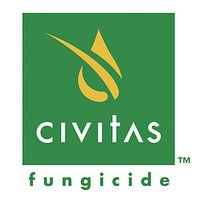
SAND, LOTS OF IT = FAST, FIRM, SMOOTH, HEALTHY BENTGRASS FAIRWAYS
Jerry Kershasky, Westmoor Country Club, Brookfield, WIWhy sand the fairways? From a golfers perspective: longer drives, consistent ball reaction with bump and run approach shots, firm up-right turf for excellent club to ball striking performance, swing plane angle superior due to positive foot, leg and hip pivoting on the firmer surface, no plugged lies, less fatigue pushing a cart or carrying your bag, use of golf cars more frequently after rains, no muddy core aeration or multitudes of earthworm casts to interfere with THE GAME.
From an agronomic perspective: less disease, better drainage, deeper rooting, superior wear tolerance, fewer earthworm Poa-planting casts, competitive advantage for bentgrass over Poa annua means less winter-kill potential, fewer summer stress situations, organic matter control, less scalp potential, fewer chemical inputs, better drought avoidance means fewer irrigation events and the ability to use equipment much sooner after heavy rains and snow melts. All of this equates out to economic and quality sustainability.
To reap all of the above you need at least a 2" layer of sand. The maximum you can safely apply in the cooler spring and fall period is 1/4" per applicatio. This is best done in two 1/8" applications with incorporation of the sand into the canopy between the 1/8" applications. During the summer months 1/20" to 1/16" should be the target so as to avoid the smothering of turf and tissue damage that would be caused by incorporation techniques of higher quantities.
Our goal is to apply 3/4" of sand per year with a ultimate target depth of 4". Once the 4" depth is attained our yearly total will be reduced to just over 1/4" for maintenance of the surface.
Visit Jerry's blog at http://westmoorturf.blogspot.com
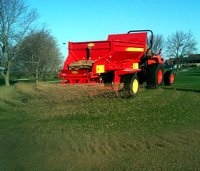
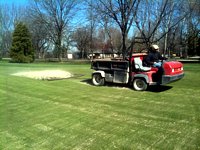
Greens venting
Greig Barker, Highland Country Club, London, OntarioToday we will be venting our greens. This process involves using our greens aerifiers to punch very small holes with solid tines. This process does not affect play or the roll of the golf ball. However, it does greatly affect the amount of beneficial air that we can get into the root zone of our greens.
This season we are using a very precise moisture meter to measure moisture in our greens. The maximum % that our greens should ever read is approximately 35% (at field capacity). Currently we are getting readings of anywhere from 40-59%. This tells us that the soil has reached complete saturation and cannot take on any more water. Our greens are drained, but the amount of precipitation that we have received is overwhelming to the soils and drainage system. With this much water holding in our greens profile, there is little room for vital root growth. The heat and humidity that is upon us now coupled with these high moisture levels can be very detrimental to the health of our greens. This is a preventative measure that can reap huge returns down the road this summer.
As you can see from the picture, the venting tine is dwarfed by a pen. Once rolled, the holes are virtually undetectable.
Visit Greig's blog at http://highlandccgroundsdept.blogspot.com
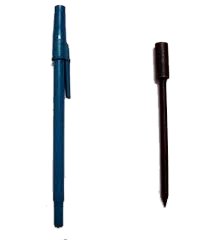
Greens To Get a Little Love!
Paul Sabino, The Farms Country Club, Wallingford, CTNext week is the perfect opportunity to perform some uninvasive maintenance practices that will help our greens survive the stress of summer. There is no outing on Monday June 13th and no events scheduled until the FWGA Super Senior event on Thursday June 16th.
Both the golf schedule and the long range forecast are perfect for us to accomplish our goals of balancing turf health with member satisfaction. While playing conditions won't be ideal on Monday June 13th and Tuesday June 14th, the results for the rest of the week and beyond will be very positive. We are going to lightly verticutt, needle-tine (vent) and topdress the greens. Verticutting helps reduce grain and needle-tining helps get necessary oxygen to the roots of the turf plant. Topdressing smoothes the surface and enhances the results from both processes. By Wednesday or Thursday our members will notice the improved putting conditions and turf health will increase! A "win-win" situation!
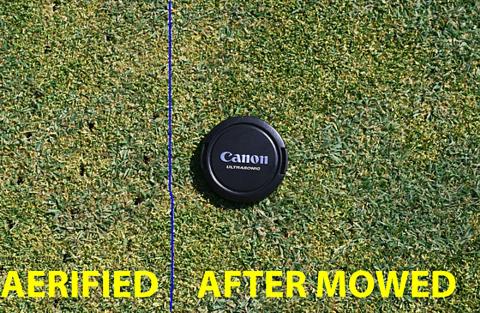
We do our best to balance these types of health maximizing maintenance practices so we can increase and extend premium playability during the prime playing season. It is a delicate balancing act indeed.
I encourage you to continually provide me with feedback on our results. The maintenance plan is a program based on many ever-changing factors designed to maximize your positive experience. We take advantage of every "off-peak" opportunity to continually give you premium "in-peak" results.
Don't misunderstand what I'm saying... Monday and Tuesday will not be so bad! Yes we will be busy and in your way from time to time, but the positive results will be long lived and well worth the minor inconvenience.
Visit Paul's blog at http://farmsccsuperintendent.blogspot.com
Special offer from TurfNet!
Want a professionally-designed custom theme for your blog?Often it's the "little extra" that separates the ordinary from the extraordinary. Whether you have an existing blog or would like to start one but don't have a clue about image editing or graphic design, we can help. If you'd like to put a little polish on your blog, we can work up a custom theme (graphics, colors, sidebar block styles, background, etc) for you! Check out the ones below that we did for Rick Tegtmeier and Jeff Johnson (and click thru for a better look):


All we need is a good head-shot photo of yourself (if desired), several good scenic shots of your course and a club/course logo (again, if desired). Then give us an idea of a color scheme (club colors, light/dark, etc.) Contact Peter McCormick if interested.
Oh yeah, the cost: Nada. Squatola. Zero. Zip. Free. But just for TurfNet members - with our thanks for supporting what we do. Feel guilty about it? ![]() Just refer a new member and we'll be very happy!
Just refer a new member and we'll be very happy!

TurfNet members: Want to share something from your blog? Send us the link.
Turf Blog Aggregator(TM) is a trademark of Turnstile Media Group.






